|
FAQs about Blue-Green Algae Identification
1
Related Articles: Blue-Green
"Algae"/(Cyanobacteria), Embracing
Biodiversity, Green Algae By Mark E. Evans, Green Algae, Green Algae 2, Avoiding Algae Problems in Marine System,
Algae
Control, Marine Maintenance,
Nutrient Control and Export,
Marine Scavengers, Snails, Hermit
Crabs, Mithrax/Emerald
Green Crabs, Sea Urchins, Blennies, Algae
Filters, Ctenochaetus/Bristle Mouth
Tangs, Zebrasoma/Sailfin Tangs,
Skimmers, Skimmer Selection, Marine Algae, Coralline Algae, Green Algae, Brown
Algae, Diatoms, Brown Algae,
Related FAQs: BGA/Cyano ID 2, BGA/Cyano ID 3, BGA/Cyano ID 4, & Controlling: BGA/Cyano,
Green Macro-Algae ID 1, Caulerpas, Green
Macro-Algae 1, Green
Macro-Algae 2, Green
Macro-Algae 3, Green Macro-Algae
4, Chlorophyte Behavior,
Chlorophyte
Compatibility/Control, Chlorophyte Selection, Chlorophyte Systems, Chlorophyte Nutrition, Chlorophyte Disease, Chlorophyte Reproduction/Propagation,
Marine Algae ID 1, Marine Algae ID 2, Marine Algae Control FAQs II, Marine Algaecide Use, Nutrient Limitation, Marine Algae Eaters, Culturing Macro-Algae; Red/Encrusting Algae, Green Algae, Brown/Diatom Algae,
|
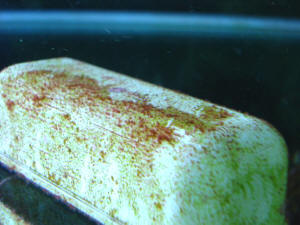
Cyanobacteria "come" as slimes, free-floating
unicellular and colonial forms, and attached varieties... In red,
blue, black and green colours
|
 |
New Print and
eBook on Amazon
Marine Aquarium Algae Control
by Robert (Bob) Fenner
|
| Algae ID 7/5/08 (2 photos
attached) Hey gang. I trust you all had a good 4th (assuming you
celebrated it). <Ah, no... not really. Not into this type of rah
rah so-called patriotism. A real patriot would be out doing what
they could to bring about the overthrow of the current regimes at
the fed., some State levels.> I'm sorry to bother you kind
folks again, but I'm having trouble identifying some type of
brown algae that has taken a foothold in my tank. Here are the tank
spec's: 65 gallon tank, ~70 pounds of live rock, 20 gallon sump
and 6XT5 lighting. Ammonia, nitrite and nitrate all 0, specific
gravity 1.025. Top off done daily with 0 TDS RO/DI water and 10%
water changes every weekend (is it Saturday already?!). It also
enjoys candlelit dinners and long walks on the beach. Wait,
that's a different questionnaire. Never mind....... Anyway,
I'm sure just as the same with all algae's, excess
nutrients are feeding it, but I have yet to find this type on your
website. I'm sure it's there somewhere, but I've looked
over countless pages the past week and haven't found a photo
that resembles it. Any thoughts? Thanks for your time. -wuf
<Very likely this mulm is mostly a BGA... If you look under a
scope of moderate power you'll be able to see... Read here:
http://wetwebmedia.com/bgaidfaqs.htm and the linked files above.
Bob Fenner> |
|
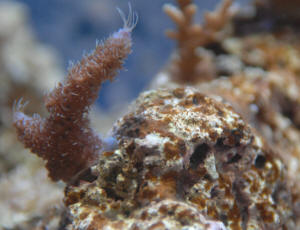 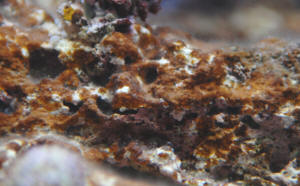
Re: Algae ID 7/6/08 Thanks for the response Mr. Fenner.
<Welcome... wuf!> I don't think this is BGA
(Cyanobacteria). It doesn't come off the rock easily at all,
and isn't THAT fast of a grower. <Mmm, neither of which
are salient characteristics...> Attached is a link to an
animated gif that shows 8 weeks of growth on a frag, and you can
see the algae starting to grow during that 8 week period.
http://samwolfe.com/photos/acro.gif <Interesting> Sorry to
be a bother. -wuf <Not a bother. Do know that it is impossible
to ID Thallophytes, Cyanophytes by simple macro-viewing... Again,
a simple look/see will reveal whether much of this life lacks
nuclei... a definitive difference twixt. Please do read where you
were referred to. BobF>
|
|
Diatom Bloom... BGA 3/20/08 Hi
Crew, <Hello there.> I seek your advice once again.
Recently I've experienced what appears to be a diatom/Cyano
bloom. <It is what it appears to be.> I have a 90 FOWLR.
The recent change I've made was switching from 110W PC's
to the Nova Extreme Pro T5 HO (324W). I'd like to start
introducing polyps, xenia, etc to start into the reefkeeping
life. <Great!> I started seeing this bloom around the time
of this lighting switch, but I'm not sure this is the root
cause based on the readings, which indicate I should be looking
for issues with water parameters and nutrient export.
<Exactly, while the lighting has spurred the growth, there are
underlying causes that need to be addressed.> I've tested
Phosphate (0), Silicate (0), Nitrate (.25), and pH (8.2-8.3 with
lights on). I'm using Salifert test kits, so I believe these
are reliable numbers. <Yes, these test kits are good. Do be
aware these numbers can be deceiving, nitrate and phosphate can
be used up as they are produced, allowing BGA growth and yet
still yielding low numbers when you test. The proof is in how the
tank looks.> I employ an AquaC Urchin skimmer, a 3gal refugium
w/ a DSB and Chaetomorpha (which is growing and being trimmed),
and 30% water changes every other week. I've attached a few
pics of the sand as well as the growth on the rocks. With a
diatom/Cyano, I was expecting to see this develop in more
stagnant areas, but the pics are where my powerheads are hitting
the rocks pretty much head on and is where the growth is
thriving. <They idea behind not allowing stagnate areas is to
keep detritus in suspension to be exported via your filtration
(mechanical/skimmer) or processed by live rock and its
inhabitants. The nutrients that cause the outbreak will be spread
throughout the tank, causing growth all over. It merely
originates from the stagnant areas more than others.> I'm
a bit confused on this and I'm wondering if this is really a
Cyano/diatom issue or something else. <Nothing else, BGA it
is.> You're help would be greatly appreciated, especially
if I need to be testing or looking for something else. Thanks
again <Welcome, a link with related FAQ's to help you
learn how to control this outbreak. Good luck, Scott V.>
http://www.wetwebmedia.com/bluegralgae.htm
|
|
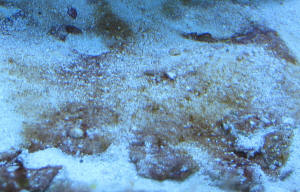 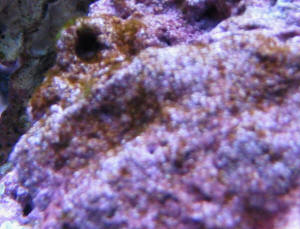
|
Red Algae Control, Input From A Querier 1/27/08 I
noticed this picture on page four of your algae ID section:
http://www.wetwebmedia.com/Algae%20and%20Plt%20Pix/BlueGreenAlgae/redstuff.JPG
Mr. Fenner identified it as red slime but it looks like red hair algae
to me, a different beast. There is a large thread over on ReefCentral
about this particular algae, "Red Nightmare Algae" or
something like that. The biological control listed in that thread is
"true Mexican Turbos" and they work very well and are quite
efficient. No other snail seems to eat this stuff. I would advise
anyone dealing with this algae not to load up too many of the large
Turbos as they are quite efficient. Five in my 75 totally eliminated
this algae (except in deep crevices) in a few days. I would hate for
someone to put 20 snails in their tank and starve them. <Good
advice.> It seems this algae doesn't need much in the way of
nutrients to survive and grows equally well under high lights and low
lights. It has even taken to growing in my macro algae (which is not
currently growing very fast). I hope you find this information useful.
Thank you for the service you provide. <Thank you for sharing. James
(Salty Dog)><<Is this yet a Cyanobacterial species? Likely so.
RMF>>
|
Red Slime Algae?? 12/26/07 You guys are
awesome and I greatly appreciate everything you are doing to help
me! You are so quick on your responses as well! Thank you.
<Happy to help.> I'm not sure if I have red slime algae
or not. I just started my 55 saltwater tank almost 2 weeks ago. I
have a 55 high tank. Wet/dry system with bioballs. Protein
skimmer, (2) 96 watt aquarium lights. One I believe is 10,000
actinic. The other is a growth light. Pinkish color. I bought the
set up used. The guy will not help me too much. As you can tell I
am new to saltwater. Experienced freshwater. My ammonia is 0.
Nitrites 0. ph was 7.7. I added a ph up and now it's 8.0.
<Start with some water changes, your ph is still on the low
side. Water changes with a good quality salt will remedy this.
Also do invest in a carbonate hardness test kit if you
haven't already.> My temp is 78. I bought 20 lbs. of Fiji
"cured" live rock. I know I need a lot more. I am
starting slow and working up to 60-90 lbs. I don't want to
shock my tank or lose a lot of money all at once. <Very
difficult to kill off live rock. It will be easier on your end to
get your rock now and cure together. Even cured rock will likely
go through a curing process once moved and placed in your
tank.> I picked a few pieces that looked very pretty because
it had a lot of purple and red coralline growth on them.
That's what the LFS told me it was. Now I am hearing more
about this red slime algae. My rock has red colored growth on it!
<Not necessarily BGA (red slime) just because its red.>
It's a dark burgundy. Included is a pic of the main rock.
<Appears to have some BGA.> There are a few others with the
same stuff on it. Just not as much. It had this on it when I
bought it. If it is Red Slime, wouldn't they treat that and
not sell it? <Not always.> I just added 6 snails, and 3
very small hermit crabs because I am going through the brown
algae cycle. (that's what they told me). <Same cause and
problem. The cleanup crew will be of little help, you need to
treat the source of the nutrients fueling it. I suspect a new
tank with curing rock, needing water changes.> They also told
me to keep my lights on 12 hours a day due to the live rock. It
was just today that I added the snails and crabs. It was after
the fact that I started seeing pics of the red slime. I have no
fish or inverts yet. Just the snails and crabs. Please tell me if
I should be worried. <No, this is normal growing pains of a
new tank. It won't hurt anything you have except the
aesthetics of the tank.> I am already sick to my stomach and
so scared to add any fish. <I wouldn't until you have all
the rock you want, unless you plan to cure any additional rock
outside your tank.> Thank you VERY MUCH for all of your help!
Raesunrae <You are very welcome. Sleep easy and read the
following links and related FAQ's regarding your situation,
Scott V.> http://www.wetwebmedia.com/bluegralgae.htm
http://wetwebmedia.com/marphalk.htm
http://wetwebmedia.com/ca/volume_2/cav2i3/Live_Rock/live_rock.htm
|
|
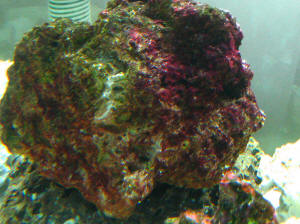 Oh yeah! Oh yeah!
|
|
Red Fuzzy Coralline? '¦Not likely,
perhaps another Rhodophyta -- 08/26/07 Hello crew! <Hi
Dave, Mich here.> I have been researching your site and others
trying to figure out what is growing in my 90-gallon reef.
<OK.> I have a red feathery/fuzzy substance growing on a
lot of my rocks, snails and hermit shells. <OK.> I was
wondering if it was a type of coralline and harmless in my tank.
<Only guessing without a pic.> I am very familiar with
Cyano and I don't think this substance is it. <OK, One of
many possibilities off the table.> It is very difficult to
scrub off, and grows in high flow areas unlike Cyano. <Still
leaves a plethora of possibilities.> I read a similar query
asked by another gentleman on your site. The reply to him was
that it was coralline, and that he should drop some vinegar on it
to see if it bubbled to be sure that it was. I tried this
experiment on my substance and it did not bubble. <Then it is
likely not coralline or any other calcium based organism.> The
other gentleman described it very well, in my opinion, by saying
it appears to look like patches of red mold. <Many nuisance
algae come to mind, red turf algae or red hair algae such as
Polysiphonia, Asparagopsis, Anotrichum barbatum, Gelidium
pusillus, or perhaps a beneficial organism such as a red tree
Foram (Homotrema rubrum) Your expertise would be greatly
appreciated. <A photo might help here.> Thank you all for
this amazing site! <Thank you for your kind words!> Dave
Kansas City, MO. <Mich Gouldsboro, PA.>
Re: Red Fuzzy Coralline? '¦Not likely, perhaps
another Rhodophyta... BGA 8/28/07 Mich, <Hi
there Dave.> Thank you, for your quick and very helpful
response! <Welcome!> I have been researching your suggested
algae species and I am continuing to have problems identifying
which is growing in my tank. <Yes, does not look like what I
was picturing in my head with out the photos.> I hope that
they attached picture of the red substance growing on my glass
magnet might help you take a better guess at what it is. <Mmm,
pics are helpful. Is not a red tree Foram and likely not many of
the algae I suggested previously, is a nuisance alga, likely a
Rhodophyte, but beyond that I can't tell. Perhaps RMF will
comment on the dailies page.> <<Is highly likely
Cyanobacteria... a quick look under a few hundred power
microscope would show the absence of nuclei, organelles, the
distinctive circular DNA if higher powered... Please read on WWM
re BGA... RMF>> This is the way it appears everywhere in my
tank, (rock, hermit shells, powerheads) short, red, and fuzzy.
<No fun. Perhaps some improvements in husbandry would help?
http://www.wetwebmedia.com/nutrientcontrol.htm
http://www.wetwebmedia.com/marine/maintenance/marineMaint.htm
http://www.wetwebmedia.com/avoidingalgaeproblesm.htm > Thank
you for your time, <Welcome, wish I could be more helpful.
Mich> Dave Mmm, think I forgot to move an image into the
emails with images folder... re: fw: re: Red Fuzzy Coralline?
atten: Mich <No worries... was there somewhere. Found,
posted> Also He stated earlier: It is very difficult to scrub
off, and grows in high flow areas unlike Cyano. <Is almost
assuredly BGA... B>
|
|
 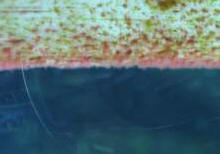
|
Cyanobacteria... specifically? 7/6/07 Anyone know
specifically which species/genera of Cyanobacteria we see in our
aquariums? <There are at least dozens...> Are they any of the
same ones scientists are studying to figure out what causes the
conversion of reef communities from coral- to algal-dominated (i.e. the
Tolypothrix sp., Schizothrix sp., Lyngbya sp., etc.)? Thanks, Sara
<At least the two genera are found at times. Re: studies on the
issue you state, I know naught. However, a visit to a large library
with computer search capabilities should reveal such if so in a short
while. Bob Fenner>
 |
New Print and
eBook on Amazon
Marine Aquarium Algae Control
by Robert (Bob) Fenner
|
|
|

